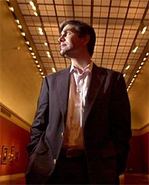A factor in Seattle’s cultural DNA is the tendency to underplay. While a steady (and welcome) influx of people from diverse cultural backgrounds has made this inherent aversion to fuss less noticeable, it remains a key factor in the city’s identity. In art circles, working hard to get noticed is still perceived as lamentable.
In Greece, the same thing is known as avoiding the evil eye. If two Greek mothers meet on the street, one might say, “What an ugly baby.” The other might reply, “Yours also.” Praise attracts the jealously malign. Self-praise secures it.
Before seeing S’abadeb — The Gifts: Pacific Coast Salish Art and Artists at the Seattle Art Museum last fall, I imagined the city’s aversion to fuss had roots in the large number of people who live here with Norwegian and Japan ancestries, where the trait is dominant.
In fact, the source is a older.
From my review:
By choice and by circumstance, Coast Salish peoples are silent partners in the internationally celebrated style of Northwest Coast Indians. Intimate instead of assertive, their art is overshadowed by the colorful bilateral geometries carved and painted on masks, boxes and totem poles of the peoples from the north, including the Kwakwaka’wakw (Kwakiutl), Bella Coola, Haida, Tsimshian and Tlingit.
The Coast Salish were living in Seattle when the Point Elliot Treaty of 1855 drove them to the outskirts of their territory and later failed to deliver a range of promised compensations.
Coast Salish art is Seattle’s root music. It’s the basis for what came after, even when the people behind it were no longer dominant on the scene.
Call it the poetics of the handyman. Everything is for use, and the sacred reveals its nature in its refusal to make a fuss. If gray was good enough for a goat, a carefully crafted gray is good enough for a weaving made of goat hair.
Just how good is that weaving?
The best are very good indeed, among the finest in the Northwest, although a traditional Coast Salish weaver wouldn’t say so.
Why puff up? The quality of a dress woven in soft cedar bark or a blanket of animal hair speaks for itself.Instead of totem poles that advertise the power of a clan, there are house posts carved in a fluid, naturalistic style that can’t be found anywhere else in the lexicon of Northwest Coast art. Coast Salish cultures don’t have clans. They have family groups linked to other family groups, and their potlatches (gift exchanges) continue to be homey instead of extravagant.
Back to Derrick R. Cartwright, 47, director of the San Diego Museum of Art since 2004 and soon-to-be director of the Seattle Art Museum. (First story on his appointment here.) Before that, he was director of the Hood Museum of Art at Dartmouth College and the Musee d’Art Americain Giverny in France.
 (Photo, Howard Lipin/ Union-Tribune)
(Photo, Howard Lipin/ Union-Tribune)
His Ph.D is in art history from the University of Michigan, where SAM’s press release says he specialized in American art and architecture and 19th-century French art, as well as the history of photography.
That’s not specializing; it’s sampling. While not the usual path for a scholar, his range of interests (he has since added one in Asian art, historical and contemporary) prepares him for life at a museum such as SAM, with its wide-ranging collection base.
And his (quiet) passion for art precedes him.
Susan Muchnic noted on Culture Monster (LA Times) that in San Diego, Cartwright “is credited with building the Balboa Park museum’s international reputation, reaching out to a diverse community and enhancing the exhibitions and publications programs.”
Before him, this border town museum had no gallery devoted to Mexican art. Now it does, along with programming focused on the Hispanic community’s cultural interests.
After Cartwright was hired in San Diego, the art critic Robert L. Pincus wrote:
Though he is highly personable and
easygoing, he possesses both an underlying intensity and vision of what he
believes to be the role of the museum director in the early 21st
century.
smaller and less interesting than SAM. At this stage, I’m not worried
about him at all. He appears to be an excellent choice, partly because
of his character. In the first five minutes of meeting him, his
confident modesty was apparent. He likes to listen, positively revels
in it. When he talks, it’s not boiler-plate, and he’s self-effacing in
the best Seattle style.
I want to build on the
strengths that are here and listen to a lot of people before making any
changes…. Mimi Gates is one of the great museum leaders of our era,
not just because of the expansion downtown, the development of the
Asian Art Museum (in Volunteer Park) and the opening of the Olympic
Sculpture Park. She has integrity and vision, and I’m proud to succeed
her.
It’s good that he knows he’s stepping into some large high heels. (My profile of Gates here.)
Board member Jon Shirley (and main patron of the Olympic Sculpture Park), laid out key points of mission:
To
reach a broader audience in this community and raise the museum to the
top tier nationally. Fund raising, of course. Remember that Mimi didn’t
have fund raising experience when she arrived. (Cartwright) has
authentic integrity and a primary focus on art.
Asked
what he hopes to be able to say about Cartwright in five years, Shirley
said, “That he’s signed up for another five years.”
Cartwright:
I
want to get to know the community and immerse myself in Seattle’s
cultural scene…Smart people support excellence. Fund raising follows
that. These are challenging times, but I’m essentially an optimist.
ArtDaily.Org here. Seattle Times on Cartwright here. Jen Graves here. Seattle PI here. Excellent interview from the San Diego Magazine in 2004 here. Seattle Art Blog here. Culture Grrl here.
Best piece on the Seattle story? Not from Seattle: Pincus (again), here.



Leave a Reply